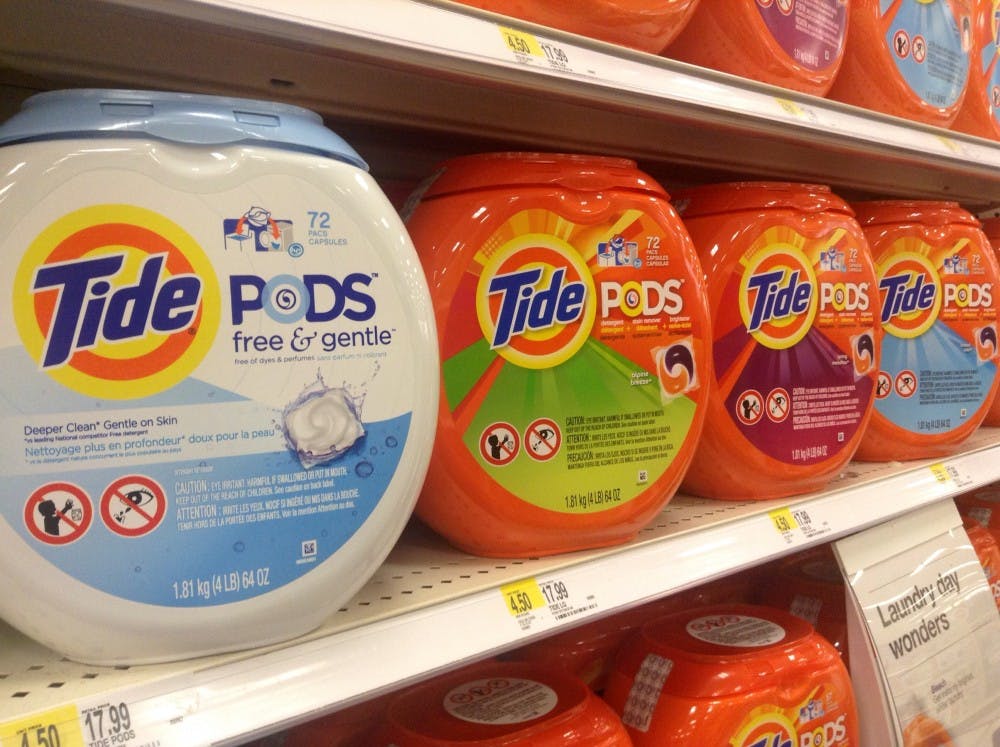In recent weeks, the viral “Tide Pod Challenge”— in which participants ingest single-load detergent packets — has been the subject of national news coverage. While it goes without saying that ingesting Tide Pods is unbelievably dangerous, it is important to note that — despite the global coverage that the “Tide Pod Challenge” has received — 2018 thus far has seen just slightly less than 100 intentional ingestions of Tide Pods in the United States. Rather than focus on the limited impacts the “Tide Pod Challenge” has had on the American populace thus far, mainstream media sources should be focused on covering the actual threats posed by such packets. Namely, their attractiveness to young children and those suffering from dementia.
The origin of the “Tide Pod Challenge” comes (perhaps unsurprisingly) from a 2015 article published by The Onion. The publication of numerous satirical articles and videos concerning the consumption of Tide Pods led to the challenge’s surge in popularity, resulting in the attention of mainstream media outlets and prompting a response from Proctor & Gamble, who stated that “…They should only be used to clean clothes and kept up, closed, and away from children.”
Despite the disproportionately large coverage that such a challenge has received, the overwhelming majority of American teenagers have abstained from consuming Tide Pods — the most recent report by the American Association of Poison Control Centers found “thirty-nine intentional exposures among thirteen to nineteen year olds. That number has increased to eighty-six such intentional cases … during the first three weeks of 2018.” Although any spike in intentional poisonings as a result of packet ingestion is certainly cause for worry, the overall number of cases in no way comprises a significant percentage of the American teenage population — the 2010 U.S. census alone counted 22,040,343 individuals aged 15-19. These poisoning cases represent less than 0.00001 percent of the U.S. teenage population — hardly a reason for such widespread news coverage.
Although ingesting detergent pods is not a serious problem for the U.S. teenage population, it does pose a more significant threat towards young children and those suffering from dementia. This particular issue is not a new one — as far back as 2012, U.S. Senator Charles E. Schumer noted that, “These pods were supposed to make household chores easier, not tempt our children to swallow harmful chemicals. I saw one on my staffer’s desk and wanted to eat it.” Those with dementia have mistaken such pods to be candy, resulting in the deaths of at least six adults from 2012-17.
Furthermore, from 2013-17, there were over 56,000 (10,000 in 2017 alone) reported cases of human exposure “for kids 5 years old and younger, to single-load laundry packets...” In fact, the Center for Disease Control released a statement in 2012 discussing possible health hazards posed to children by such laundry detergent pods, stating that “Health-care providers should be aware that exposure to laundry detergent from pods might be associated with adverse health effects more often than exposure to non-pod laundry detergents.” Although manufacturer changes in 2015 resulted in a 39 percent decrease in accidental exposures to liquid laundry packets, Consumer Reports noted that “that’s relative to the number sold, which had increased ... Consumer Reports has seen no evidence that the raw number of accidental exposures has decreased.”
The underlying problems posed by detergent pods — namely, their striking similarity to candies towards the young and mentally impaired — have been known for at least half a decade. Yet, it was the “Tide Pod Challenge” in 2017 which received extensive national and global coverage — while coverage of such products prior to the emergence of this challenge received more muted headlines. Although the outlandish coverage of the “Tide Pod Challenge” is no doubt attributable to its absurd nature (and incredibly deadly consequences compared to more benign Internet challenges), mainstream media outlets can — and should — focus on the long-term impact of introducing such detergent pods to the general populace, and their possible effects on young children and those beset with dementia.
The overall coverage of the “Tide Pod Challenge” serves as an indicator of mainstream media outlets’ tendencies to exaggerate the impact of more outlandish or unique events. Though useful in obtaining ad revenue, this focus on shocking events means that more common issues facing the American populace — an opioid epidemic that the Trump administration has yet to take any concrete action against, or accelerating temperature increases — fail to receive extensive coverage, despite their national (and global) implications.







